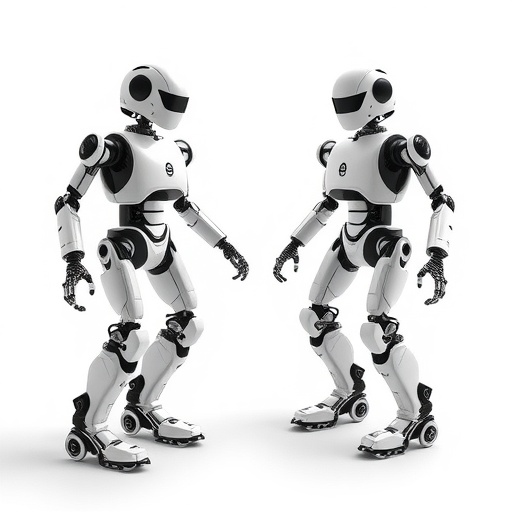
In an era where robotics plays a crucial role in various applicationsâfrom manufacturing to explorationâthe development of efficient formation control techniques for networked robots has emerged as a prominent field of study. The research led by Zhao, Chen, and Ding presents a notable advancement in this area: finite-time distributed optimization formation control of networked robots under time-varying reference signals while working with directed graphs. The implications of this research are profound, offering solutions that could tremendously impact how robots collaborate and perform tasks in dynamic environments.
Formation control dictates how a group of robots maintains a specified spatial arrangement while moving collectively towards a designated goal. Traditional methods often assume static reference signals; however, as real-world scenarios involve fluctuating conditions and requirements, the necessity for time-varying references is paramount. The approach proposed by the researchers effectively addresses this need, ensuring that robots can adapt instantaneously to changes in their operating environment, leading to enhanced performance and reliability.
Directed graphs are utilized as a framework for modeling the interaction and communication between networked robots. Each node represents a robot, while the edges signify the directed relationships, showcasing how information is transmitted within the network. The introduction of directed graphs in their optimization approach allows the robots to achieve distributed control, meaning each robot can take autonomous actions based on local information, thus boosting overall system robustness and adaptability.
Moreover, the finite-time aspect of their control strategy distinguishes this work from traditional infinite-time approaches that often require prolonged periods for settling into the desired formation. This finite-time convergence guarantees that robots reach their target configurations swiftly, an essential feature when dealing with real-time applications such as disaster response, search and rescue missions, and collaborative exploration, where every second counts and rapid decision-making is crucial.
To ensure the effectiveness of the proposed control mechanism, the authors provide a comprehensive mathematical framework. Their process begins with the establishment of dynamic models that define how each robot should adjust its position in relation to others based on the prevailing conditions dictated by the time-varying reference signals. The development of algorithms to solve these dynamic equations forms the backbone of their research, catering to the complexities that directed graphs introduce.
In addition to the formulation of the control strategy, the researchers conducted extensive simulation experiments to validate their theoretical findings. By modeling various scenarios with multiple robots and diverse reference signal conditions, they were able to assess the efficacy of their approach robustly. The results demonstrated not only the feasibility of their method but also its superiority when compared to existing modelsâhighlighting faster convergence times and greater resilience to network disruptions.
This advancement is especially pertinent when considering how robotic formations can be utilized in challenging and unpredictable environments. Whether itâs swarming drones for environmental monitoring or coordinated underwater robots for ocean exploration, the ability to maintain an optimal formation quickly and efficiently under variable conditions is a game-changer. Zhao, Chen, and Ding’s research has laid the groundwork for these applications by presenting a model that can continually adapt, ensuring that robotic teams function seamlessly.
Beyond practical applications, the implications of this research extend into theoretical domains within areas such as control theory and networked systems. The engagement with directed graphs offers fresh insights into how more complex relationships among robots can be harnessed to improve performance metrics. The work also sheds light on potential future explorations into multi-robot systems, suggesting pathways for further investigation into collaborative efforts with heterogeneous robotic units.
Additionally, the interplay of optimization with formation control may inspire further research into diverse fields such as autonomous vehicles and smart infrastructure. By leveraging the core principles detailed in Zhao, Chen, and Ding’s study, new methodologies could be developed that improve cooperative behavior amongst various automated systems, fostering a future where sophisticated robotics become integral to our daily lives and crucial infrastructures.
In conclusion, the contributions of Zhao, Chen, and Ding not only enrich the existing literature on robotic control systems but also provide a practical framework ready for implementation in real-world scenarios. Their finite-time distributed optimization mechanism sets a new paradigm for formation control, ensuring that autonomous robots can work in concert, adapting to real-time challenges. This research signifies a crucial step toward enhancing the collaborative nature of robotics in increasingly dynamic environments.
As we venture further into uncharted territories of robotics and artificial intelligence, studies like this will undoubtedly inspire a new generation of innovations, redefining our expectations and capabilities in countless fields.
Subject of Research: Distributed optimization formation control of networked robots with time-varying reference signals under directed graphs.
Article Title: Finite-time distributed optimization formation control of networked robots with time-varying reference signals under directed graphs.
Article References:
Zhao, W., Chen, Q. & Ding, L. Finite-time distributed optimization formation control of networked robots with time-varying reference signals under directed graphs.
Discov Artif Intell 5, 184 (2025). https://doi.org/10.1007/s44163-025-00415-5
Image Credits: AI Generated
DOI: 10.1007/s44163-025-00415-5
Keywords: Distributed optimization, formation control, networked robots, time-varying reference signals, directed graphs.
Tags: adaptive robotic systemscollaborative robotics applicationscommunication in robotic networksdirected graphs in roboticsdynamic formation controlenhancing robotic performancefinite-time optimization techniquesnetworked robotsoptimization in dynamic environmentsreal-world robotics challengesspatial arrangement of robotstime-varying reference signals




